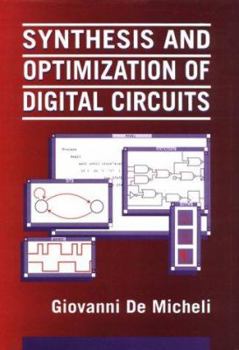Synthesis and Optimization of Digital Circuits
Select Format
Select Condition 
Book Overview
This new graduate textbook in computer engineering offers a modern, up-to-date look at computer aided design of VLSI circuits at the functional and logic level by addressing an interesting topic in... This description may be from another edition of this product.
Format:Hardcover
Language:English
ISBN:0070163332
ISBN13:9780070163331
Release Date:January 1994
Publisher:McGraw-Hill Science/Engineering/Math
Length:579 Pages
Weight:2.15 lbs.
Dimensions:1.1" x 6.7" x 9.6"
Customer Reviews
2 ratings
Synthesis at many levels
Published by Thriftbooks.com User , 18 years ago
De Micheli's book is the most complete reference I know for the aspiring tool-builder,or for the tool-user who wants to know more of what's inside the design and synthesis tools at her desk. The first hundred pages or so lay out mathematical basics. Graph theory pervades later discussion, so it gets a thorough review in this early section. There's also a little about boolean logic - not the kids' stuff, but a variety of representations, plenty to get the reader's mind set into mathematical orientation of the rest of the book. Part II, chapters 4-6 are, for me, the real meat of the presentation. They deal with the higher, architectural levels of synthesis, with a strong discussion of scheduling of shared resources. This book predates modern system-on-chip design, so it doesn't get to the level of on-chip busses and networks. The datapath and resource management issues are just as important today as when this book was written, though. And, even if it omits references from the ten-plus years since its writing, it gives today's reader a solid preparation for creating tools on the cutting edge of system synthesis. The remaining chapters, although thorough and competent, are not in the center of my interests. They deal at length with decomposition of logic and control into gate-level constructs. De Micheli's discussion goes far beyond freshman logic design since, as he points out, "Most classical methods are not practical for circuits of usual size." Chapter 10 goes beyond classic and/or decomposition, and well into the quirks and limitations of real cell libraries. FPGAs are mentioned only briefly - understandable, since they had not acquired the importance given them by the decade-plus of technology shifts since the book was written. A modern successor to this book would probably have a lot more to say about FPGA-based implementation, and would probably address placement and routing issues that De Micheli had no need to address. Despite its 1994 copyright date, this book is still current and relevant. It gives its reader a broad and rigorous start on industrial-strength synthesis. I recommend this highly to anyone seriously involved in creating tools for logic and system design. //wiredweird
Well-written, informative book
Published by Thriftbooks.com User , 24 years ago
Initially I was surprised to find no reviews for this book, considering the fact that it is widely used as a text in the schools. This book was a recommended text for my graduate course in "Electronic Design Automation". I have read the text, as well as, solved few problems in the exercises. Based on these qualifications, I think this book is very good. It starts with the basics and goes onto explain the advanced algorithms used in design automation. It gives a comprehensive coverage of the subject. For avid problem solvers, the exercises present a challenging oppurtunity. I highly recommend this book for any student of digital circuit design. But, advanced readers may find some topics (especially, formal methods) missing in this book.






